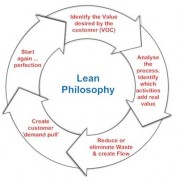LEAN Misconceptions – Part 3
LEAN Misconceptions – Part 3
In Part 2 we shed light on the fact that Lean is not a process to reduce the number of employees, which followed from the initial myth that was debunked being that Lean is all about cost reduction. In this article we explore the myth that Lean is only applicable to manufacturing.
Misconception # 3: Lean is only applicable to manufacturing organisations
The origins of Lean can be traced back to Henry Ford in the 1920’s when he developed the assembly line for the Model-T Ford. In the 1950’s, we then had the quality crusade driven by Deming and Mitrofanov’s Group Technology which was further enhanced by Burbidge in the 1970’s. In the 1980’s the Just-in-Time, Zero Inventory and Total Quality Control (JIT/TQC) era rose to the forefront, and finally Lean took center-stage with Ohno and the development of the Toyota Production System (TPS) in Japan. So while neither Ford, Deming et al, called their methodologies ‘Lean’, their approach always focused on the elimination of all forms of ‘waste’…the very essence of Lean. It was only in the 1990’s that these various approaches to process improvement were finally amalgamated and called ‘Lean’.
However, it is perhaps unfortunate that the work of the original Lean guru’s, in particular Taiichi Ohno at Toyota, all focused on manufacturing organisations, which created the perception among many business owners and managers that Lean is only applicable to companies that ‘manufacture’, i.e. service industries were explicitly excluded from becoming ‘Lean’. Thankfully however, it was left to the likes of Womack, Jones, Hines, Bicheno and others, who in the early part of this Century, clearly demonstrated that Lean is applicable ALL organisations. It has now generally accepted that Lean is applicable to every system, every process and every department within every organisation.
Implementing Lean in any business, whether a manufacturing or service provider, is based on 2 broad principles i.e.
- Understanding who the customer is and what he values from the product or service being provided. These customers may be external to the organisation, i.e. the ‘traditional’ customer, or internal, for e.g. the customers of the IT department are the other functional departments within the organisation that use the data and services provided by the IT system.
- Understanding that every function or service provided by any department or organisation, is a process that can be documented, standardised, and most importantly, improved. Improving any process necessitates the identification of waste within the process, where waste is defined as any activity that adds no value from the customer’s perspective, i.e. the extra (wasted) time, labour and materials spent producing the product or service.
Using the above premise and the fact that no business process is waste-free, Lean can be implemented in any environment, as every business process can be analysed and improved. Lean now has a proven track record within many non-manufacturing organisations, including:
- Banking and Financial services
- Hospitals and Health Care
- Engineering
- Architecture
- Food services
- Repair services of all types
- Government services
- Legal services
- IT
All these organisations have adopted the 5-Stage continuous Lean improvement cycle that always starts with identifying the value desired by the customer, or Voice of the Customer (VOC).
Mike Karle










